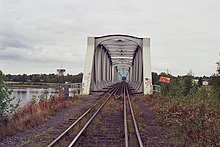
Transport in Sweden is available for all four main modes of transport—air, bus, ferry and rail—assisting residents and visitors without their own vehicle to travel around much of Sweden's 450,295 square kilometres (173,860 sq mi).

Haparanda Municipality, is a municipality in Norrbotten County in northern Sweden. Its seat is located in Haparanda.

VR-Group Plc, commonly known as VR, is a government-owned railway company in Finland. VR's most important function is the operation of Finland's passenger rail services with 250 long-distance and 800 commuter rail services every day. With 7,500 employees and net sales of €1,251 million in 2017, VR is one of the most significant operators in the Finnish public transport market area.
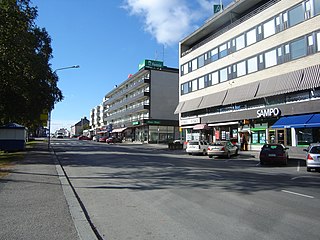
Tornio is a city and municipality in Lapland, Finland. The city forms a cross-border twin city together with Haparanda on the Swedish side. The municipality covers an area of 1,348.83 square kilometres (520.79 sq mi), of which 161.59 km2 (62.39 sq mi) is water. The population density is 17.67 inhabitants per square kilometre (45.8/sq mi), with a total population of 21,001.

The Torne, also known as the Tornio, is a river in northern Sweden and Finland. For approximately half of its length, it defines the border between these two countries. In the upper parts, the river is situated in Sweden before it meets the Muonio River where it adjoins the international border. It rises at the lake Torneträsk near the border with Norway and flows generally southeast for a distance of 522 kilometres (324 mi) into the Gulf of Bothnia. It is the largest river in Norrbotten County both by length and by watershed area.
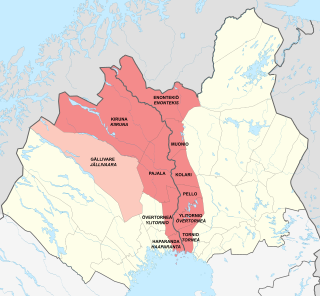
Meänmaa, or sometimes Torne Valley or Torne River Valley lies at the border of Sweden and Finland. It is named after the Torne River flowing through the valley and into the Gulf of Bothnia. Geographically the townships and municipalities that make up the area are Haparanda, Övertorneå, Pajala and Kiruna in Sweden, and Tornio, Ylitornio, Pello, Kolari, Muonio and Enontekiö in Finland. Culturally the highland Swedish municipality Gällivare is sometimes also considered part of Meänmaa due to the large share of Meänkieli-speaking population in it. Torne Valley should not be confused with Torne Valley Sub-region.
In railway engineering, "gauge" is the transverse distance between the inner surfaces of the heads of two rails, which for the vast majority of railway lines is the number of rails in place. However, it is sometimes necessary for track to carry railway vehicles with wheels matched to two different gauges. Such track is described as dual gauge – achieved either by addition of a third rail, if it will fit, or by two additional rails. Dual-gauge tracks are more expensive to configure with signals and sidings, and to maintain, than two separate single-gauge tracks. It is therefore usual to build dual-gauge or other multi-gauge tracks only when necessitated by lack of space or when tracks of two different gauges meet in marshalling yards or passenger stations. Dual-gauge tracks are by far the most common configuration, but triple-gauge tracks have been built in some situations.

Haparanda is a locality and the seat of Haparanda Municipality in Norrbotten County, Sweden. It is adjacent to Tornio, Finland. Haparanda had a population of 4,856 in 2010, out of a municipal total of 10,200 inhabitants.

Gauntlet track or interlaced track is an arrangement in which railway tracks run parallel on a single track bed and are interlaced in such a way that only one pair of rails can be used at any time. Since this requires only slightly more width than a single track, all rails can be carried on the same crossties/sleepers. Trains run on the discrete pair of rails appropriate to their direction, track gauge or loading gauge.

The Finnish railway network consists of a total track length of 9,216 km (5,727 mi). The railways are built with a broad 1,524 mm track gauge, of which 3,249 km (2,019 mi) is electrified. Passenger trains are operated by the state-owned enterprise VR that runs services on 7,225 km (4,489 mi) of track. These services cover all major cities and many rural areas, though the coverage is less than the coverage provided by the bus services. Most passenger train services originate or terminate at Helsinki Central railway station, and a large proportion of the passenger rail network radiates out of Helsinki. VR also operates freight services. Maintenance and construction of the railway network itself is the responsibility of the Finnish Rail Administration, which is a part of the Finnish Transport Agency. The network consists of six areal centres, that manage the use and maintenance of the routes in co-operation. Cargo yards and large stations may have their own signalling systems.

Rail transport in Sweden uses a network of 10,912 kilometres (6,780 mi), the 24th largest in the world. Construction of the first railway line in Sweden began in 1855. The major operator of passenger trains has traditionally been the state-owned SJ AB, though today around 70% of all rail traffic consists of subsidised local and regional trains for which the regional public transport authorities bear responsibility. Passenger traffic has increased significantly since the turn of the millennium, and in 2019 Sweden ranked number five in the world and number three in the European union, as well as number sixth in the world when measured by passenger share.
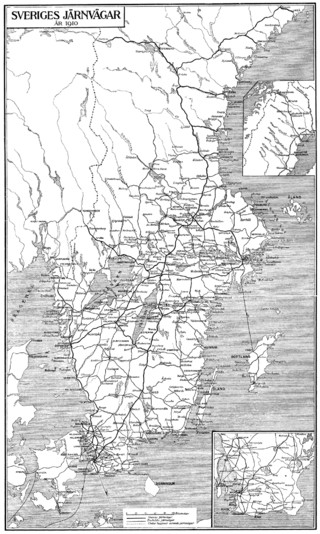
The history of Sweden's railways has included both state-owned and private railways.

A variable gauge system allows railway vehicles in a train to travel across a break of gauge between two railway networks with different track gauges. For through operation, a train must be equipped with special bogies holding variable gauge wheelsets which contain a variable gauge axle (VGA).

The Haparanda Line is a 165-kilometer (103 mi) long railway line between Boden and Haparanda in Sweden. There is a 3-kilometer (1.9 mi) long section from Haparanda to Torneå, which is on the Finnish side of the Finland–Sweden border. The line is the only Swedish railway to the Finnish border.

Finnish national road 29 is a highway in Finland between Keminmaa and Tornio. The road is part of the European route E8, except for the one kilometer section between the national boundary and the intersection with the highway 21, where the road is part of the European route E4.
The history of rail transport in Finland began on January 31, 1862, with the opening of the railway line between Helsinki and Hämeenlinna. By 1900 most of the future main lines had been constructed, including the line to St. Petersburg. By the time of the birth of the new Finnish Republic in 1917 lines connected all major cities, major ports, and reached as far as the Swedish border, and inner Finland as far north as Kontiomäki in Paltamo region, as well as eastwards into Karelia.

The Peräpohjola dialects are forms of Finnish spoken in Lapland in Finland, Sweden, and Norway. The dialect group belongs to the Western Finnish dialects and it is divided into five more specific dialect groups.
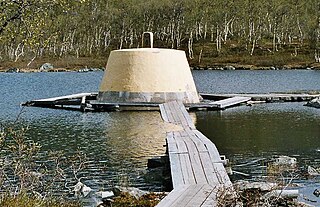
The Finland–Sweden border is the border between the countries of Finland and Sweden. Almost the entire border runs through water: along the Tornio River and its tributaries, and in the Gulf of Bothnia. Only a few kilometres of the border are on dry land. Because of the Schengen treaty and the Nordic Passport Union, the border can be crossed mostly freely.

Dresden-Friedrichstadt station is a freight yard that is, along with the two passenger stations of Dresden Hauptbahnhof and Dresden-Neustadt, a central component of the railway node of Dresden in the German state of Saxony. The station precinct, which is located in the Dresden district of Friedrichstadt, also includes a locomotive depot and a regional passenger station.


